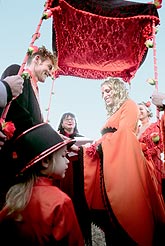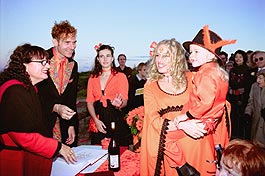
|
| Nitza conducts the wedding |
Nitza, the Jewish marriage celebrant
Author: Megan Wynne-Jones, Getting Married project
Getting Married: Nitza Lowenstein has been a civil marriage celebrant since 1995, and has officiated at several hundred weddings, in many different settings. She is well acquainted with the religious symbolism of a Jewish wedding.
Adapting the Jewish wedding to many cultures
Nitza explains that in Jewish law if one of a couple who wish to marry is non-Jewish,
a traditional religious ceremony is not possible. The granddaughter of a Rabbi,
Nitza became a celebrant because she wanted to provide a meaningful substitute
to a synagogue wedding, and something which everyone can relate to.
She has written her own ceremony which she changes to suit each couple, and
which has to encompass the legalities and paper work of civil marriage, as well
as the elements of a Jewish wedding. She enjoys her work and feels that she
has a very important role in Australian society, especially when there are so
many mixed marriages performed.
 |
 |
|
(Nitza) People want to bring in their culture, their heritage into the
ceremony, and they can. And they can be proud of it. And it's a very good start
to the marriage if people acknowledge each other's culture and each other's
heritage…
|
Wedding traditions - the hoopa
One of the Jewish wedding traditions which couples may chose to retain is the
hoopa.
 |
 |
|
The hoopa, or the marriage canopy
underneath which we stand at the wedding, is a cultural symbol representing
the new happy home that the bride and groom will build and create together.
The hoopa is covered on top as a symbol of security
and protection and is open on all sides so that family and friends will always
feel welcome.
|
In a traditional Jewish wedding the groom waits under the hoopa, and
when the bride approaches she circles him seven times before joining him. There
are several meanings attached to this. The number seven is an omen of good fortune,
linked to the seven days of creation. The circling is also a means of protection,
from evil spirits and from the temptations of the world.
 |
 |
|
It creates space around the bridegroom, to separate him from
his family… The bride goes into that space she created, so now she's part
of his world, his space, and they are creating a new family together…
|
Traditionally, the parents of both bride and groom will also stand under the
hoopa with the couple. With the couple and their parents under the
hoopa, the wedding is solemnized with the wedding vows and a ring.
Traditionally, the woman would accept a ring from the man, on the index finger
of her right hand. The man would say “I hereby sanctify you to be my wife”.
The couple would share wine, drinking from a goblet which would also be used
on the Jewish Sabbath. Traditionally, it would be the groom only who gives the
cup to the bride.
The seven blessings

Concluding the ceremony
At the heart of a Jewish wedding are the seven blessings. The seven blessings
celebrate the source of creation, giving thanks for the gift of each individual
life and for human beings who reflect the divine for one another. The blessings
rejoice in abundance, in love, and in the power that joins the couple, giving
thanks for happiness, peace and companionship.
Some of the blessings are:
5. Let joy surround this couple as they know the love that is paradise on earth.
6. We celebrate the power that joins them. We give thanks to the source of
creation for the gladness here today, for happiness, for song, love, harmony,
peace and companionship. May all the world soon ring out with the sounds of
happiness, the voices of lovers in joyous celebration. (Kol sason, vekol
simcha, kol chatan, vekol kala.)
7. Praised is love, blessed be this marriage. May the bride and bridegroom
rejoice together.
The ketuba
Another important element of a traditional wedding is the ketuba or
marriage contract, a tradition that is thousands of years old. Written in Aramaic,
an old Semitic language, it signifies the partners' commitment.
 |
 |
|
…The husband actually is committing himself, it's
a contract that he's going to give the wife a home, clothing, food and even
sex. It's spelled out, and if something happens and the marriage doesn't work
out he even puts a sum of money in the marriage contract, how much money she
will get as a divorce settlement...
|
For the wife, her side of the contract is to accept him as a husband. At the
end of the wedding the ketuba would be signed, and the couple are man
and wife.
Also at the conclusion of the wedding, a glass is placed at the man's
feet to be broken.
 |
 |
|
By breaking the glass while we celebrate and rejoice, we acknowledge
the misery and suffering around the world. It also serves as a reminder that
relationships are fragile and must always be treated with care, love and respect.
Its cultural significance is to symbolize that this bond, unlike the fragile
glass, is for life. Traditionally, there would be one glass only and it is the
man who breaks it.
|
Nitza's marriage
Nitza's own wedding was a traditional religious Jewish ceremony in a garden
setting in Johannesburg. Nitza remembers well the excitement of the reception
which followed the formalisation of her marriage; in particular the energetic
dancing of the hora, as she and her husband were held on chairs above the guests'
heads. As was the tradition, the couple were given a handkerchief which they
had to hold between them above the dancing guests.
Nitza has been married for 26 years. She has a secret formula for a lasting
marriage.
 |
 |
|
Good communication and strong physical attraction. If you only
have one of the thing it will never work…It's got to have this combination
of both elements.
|
>
Back to Rachel & Neill's wedding
> Take a look at some more weddings
|


